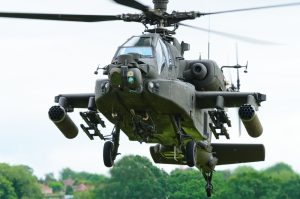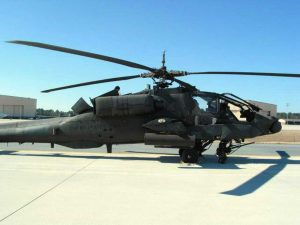
The US Army operates the most fierce and most powerful helicopters in the world, with an impressive fleet that dominates the skies. We’re not talking about your average choppers – we’re diving into the world of Black Hawks, Apaches, Chinooks, and Little Birds.
Picture this: you’re hovering over rugged terrain in a UH-60 Black Hawk or zooming past obstacles in an MH-6 Little Bird. Or maybe you’re unleashing firepower from an AH-64 Apache or carrying critical cargo with a CH-47 Chinook. That’s just another day for US Army helicopters!
Are you intrigued yet?
Brace yourself as we delve into the rigors of training needed to master these high-tech wonders and how technology is constantly upping the ante in modern warfare.
US Army Helicopters Table of Contents:
- Overview of US Army Helicopters
- Top US Army Helicopters
- Technological Advancements in Military Helicopters
- Training and Maintenance of Military Helicopters
- FAQs about US Army Helicopters
- Conclusion

Overview of US Army Helicopters
The United States military operates a diverse fleet of over 5,000 helicopters. These machines are not just tools for transportation, but they also serve in vital roles from logistics to combat and rescue operations.
Role of Helicopters in the US Army
US Army helicopters are workhorses that have changed the face of modern warfare. They carry troops into battle zones, evacuate wounded soldiers, and deliver essential supplies. But it’s not all about utility; these airborne powerhouses can pack quite a punch.
Troop transport is one critical function where speed and maneuverability come into play. Imagine being able to bypass roads filled with IEDs or avoiding enemy fire on the ground – this is what helicopters let our brave servicemen do every day.
Beyond moving personnel and equipment around, some choppers also take center stage during combat missions. Equipped with machine guns, rockets, or torpedoes for naval engagements – when you see an Apache or Black Hawk coming your way, you know things are about to get real.
In contrast to their destructive capabilities is their life-saving role in search-and-rescue missions (SAR). In treacherous terrains or hostile territories where conventional vehicles cannot reach easily, helicopters become lifelines for those stranded or injured.
Military helicopters hold an irreplaceable position within our armed forces ‘ arsenal, no matter how you slice it – be it logistics support in peace times or frontline action during conflict. More details here.
Top US Army Helicopters
The UH-60 Black Hawk, AH-64 Apache, CH-47 Chinook, and MH-6 Little Bird are the real workhorses of the sky for the United States military. Everyone is designed to meet particular needs for both combat and non-combat situations.
#1 UH-60 Black Hawk
The UH-60 Black Hawk, in service since 1979, serves a variety of roles, from troop transport to medical evacuation. It’s like your reliable family minivan – if that van could also airlift you out of danger.
The UH-60A/L Black Hawk Helicopter is a highly versatile military aircraft known for its durability and multifunctional capabilities. Designed for a variety of missions, it serves a crucial role in the military for troop transport, medical evacuation, and logistics support.
Key Features and Capabilities
- Versatility: Equipped to handle a range of missions, from assault and air cavalry to medical and humanitarian operations.
- Durability: Built to withstand challenging environments, the Black Hawk is renowned for its ruggedness and reliability in combat zones.
- Capacity and Performance: Capable of carrying up to 11 fully equipped soldiers or a medical evacuation team, it features a powerful engine that enables swift transport and efficient maneuvers.
- Advanced Avionics: Boasting state-of-the-art navigation and communication systems, the UH-60A/L ensures mission effectiveness and safety under various operational conditions.
Operational Significance
In service with militaries around the world, the UH-60A/L Black Hawk Helicopter plays a pivotal role in enhancing operational readiness. Its capabilities make it indispensable for rapid deployment and critical operations, including search and rescue missions, as well as tactical airlift of supplies.
This helicopter’s design and engineering emphasize its adaptability, making it an integral component of modern military aviation forces. Whether performing transportation duties or supporting frontline operations, the Black Hawk consistently delivers reliable performance under pressure.
#2 AH-64 Apache
- The AH-64 Apache Longbow is an advanced multi-role attack helicopter developed to dominate on the modern battlefield. Built with cutting-edge technology, it provides superior attack capabilities, reconnaissance features, and tactical superiority.
Key Features of the AH-64 Apache Longbow:
- Advanced Targeting and Navigation: Equipped with a Longbow radar system, it can detect, classify, and prioritize up to 128 targets simultaneously. This makes it incredibly efficient in both day and night operations as well as adverse weather conditions.
- Weapon Systems: The Apache Longbow is armed with a 30mm Chain Gun mounted under its nose, along with Hellfire missiles and Hydra 70 rocket pods. These powerful weapons ensure it can engage and destroy enemy defenses with precision.
- Survivability: Designed with enhanced armor and countermeasure systems, the helicopter can withstand small arms fire and evade enemy radar, increasing its survivability in hostile environments.
- Mobility and Performance: Capable of speeds up to 150 knots, the Apache Longbow maneuvers swiftly, allowing it to respond rapidly to threats and provide close air support to ground troops.
Tactical Advantages: The helicopter is not just about firepower; it integrates into larger military strategies, offering real-time data to command centers. This synergy helps enhance mission success and reduce risks for ground operations. In summary, the AH-64 Apache Longbow is a cornerstone of modern military aviation, offering unparalleled attack capabilities, advanced technology, and robust defensive features essential for achieving tactical dominance in various combat scenarios.
#3 CH-47 Chinook
The heavy-lifting champion in this lineup is the CH–47 Chinook. Since 1962, it has been able to carry up to 55 troops or a whopping 24k pounds worth of cargo. Think semi-truck but airborne.
The MH-47 Chinook is a heavy-lift helicopter designed to perform a range of military operations. Originating from the renowned Boeing CH-47 Chinook model, this aircraft is specifically engineered for special operations forces.
The CH-47D Chinook is a versatile, twin-engine helicopter renowned for its heavy-lift capabilities. Developed by Boeing, this aircraft serves as a backbone for military operations worldwide. Its robust design features a tandem rotor system that allows it to transport troops, artillery, vehicles, and supplies with ease.
Key Features
- Heavy-Lift Capability: The CH-47D can carry up to 28,000 pounds, making it invaluable for moving large equipment and cargo.
- Speed and Range: It can reach speeds of up to 175 mph and has an operational range of approximately 400 miles, ensuring rapid deployment and flexibility on the battlefield.
- Versatility: Beyond military missions, it is often employed in disaster relief operations, delivering aid to areas inaccessible by other means.
- Advanced Avionics: This model is equipped with state-of-the-art navigation and communication systems that enhance its operational effectiveness in diverse environments.
Operational Use
The CH-47D has been a part of numerous military campaigns, proving its reliability and rugged performance in various terrains and weather conditions. From high-altitude mountain missions to desert operations, its adaptability makes it a critical asset for military forces.
In summary, the CH-47D Chinook is more than just a helicopter; it’s a crucial component in logistical support and tactical operations, reflecting its legacy of dependability and strength in aviation.
Key Features:
- Versatility: It excels in a variety of missions, including troop transport, heavy cargo lifting, and aerial refueling.
- Enhanced Systems: Equipped with advanced avionics and navigation systems, the MH-47 can undertake complex missions in diverse environments, including during nighttime and adverse weather conditions.
- In-Flight Refueling: One of its standout features is the capability for in-flight refueling, extending its operational range significantly.
Mission Capabilities:
- Personnel Transport: Designed to rapidly move special operations forces into and out of hot zones.
- Cargo Lifting: With its powerful tandem rotor system, it can carry large weights, such as vehicles or artillery.
- Search and Rescue: Although primarily used for combat missions, it can also be involved in search and rescue operations, thanks to its robust build and reliability.
The MH-47 Chinook is an essential part of military aviation, representing strength and adaptability critical to modern military strategies. Its ability to perform a wide range of tasks effectively makes it indispensable for special ops missions worldwide.
#4 What is the UH-72A Lakota?
The UH-72A Lakota is a versatile utility helicopter used by the U.S. Army. This aircraft is primarily designed for non-combat roles, such as logistics and training, making it a crucial asset for operations that don’t involve front-line engagement.
Key Features:
- Multirole Capabilities: The UH-72A excels in medical evacuation, reconnaissance, and border security missions. Its flexibility makes it suitable for various non-combat military tasks.
- Modern Technology: Equipped with advanced avionics and communication systems, the Lakota ensures efficient mission operations and connectivity in the field.
- Cost-Efficient: The helicopter is known for its cost-effective maintenance and operational efficiency, making it a practical choice for the military‘s diverse needs.
The Lakota’s reliability and adaptability make it a valuable tool for supporting U.S. Army missions domestically, providing crucial support without the complexities associated with combat helicopter operations.
#5 Understanding the OH-58D Kiowa Warrior
The OH-58D Kiowa Warrior is a military helicopter renowned for its versatile role in armed reconnaissance and attack missions. Originally developed by Bell Helicopter, this aircraft has been an integral component of the military‘s operational fleet.
Key Features
- Design and Structure:
- Lightweight and Agile: Known for its lightweight and compact design, the Kiowa Warrior excels in maneuverability, making it ideal for reconnaissance tasks.
- Advanced Cockpit Technology: Equipped with a modern cockpit that provides pilots with a wide array of navigation and flight information.
- Performance Abilities:
- Speed and Range: Capable of reaching speeds that allow rapid response to battlefield situations, with a range that supports extended missions without frequent refueling.
- Night and All-weather Operation: Engineered with advanced sensors and imaging systems, enabling operations both day and night, regardless of weather conditions.
- Armaments:
- Weapon Systems: Outfitted with a variety of weapons including machine guns and missiles, providing both defensive and offensive capabilities.
- Target Acquisition: Utilizes sophisticated sighting systems to identify and engage targets with precision.
Operational Role
The primary role of the OH-58D Kiowa Warrior is reconnaissance. It is relied upon to scout enemy positions and gather intelligence crucial for mission planning. Additionally, its attack capabilities enable it to engage targets directly, supporting ground troops in a multi-faceted combat environment.
Versatility in Missions
Due to its design and technology, the Kiowa Warrior can undertake various missions, ranging from surveillance to direct combat support. It’s often used in pairs for missions, with one aircraft observing while the other provides cover.
Importance in Military Use
The OH-58D Kiowa Warrior remains a noteworthy asset in military aviation due to its adaptability and effectiveness in a range of operations. Though some units have been phased out or replaced by newer models, the Kiowa’s influence persists in modern reconnaissance and combat helicopter design.
In summary, the OH-58D Kiowa Warrior is a dynamic and robust helicopter, specifically designed to excel in reconnaissance and light attack roles, offering vital support through its agility, advanced technology, and versatile mission capabilities.
#6 MH–6 Little Bird
Last but not least, we have got our agile ninja – The MH–6 Little Bird. It is often used for covert insertions and extractions due to its small size. Like a sparrow in the wind, it slips in and out undetected.
The MH–6 Little Bird, officially known as the “Killer Egg” for its unique design, is a light helicopter with a reputation for versatility and stealth. Developed in the 1960s and entering service in the 1980s, this nimble aircraft has been a staple in special operations.
Key Features
- Size and Agility: Its compact frame allows it to navigate tight spaces and land in confined areas where larger helicopters cannot go.
- Performance: With a cruising speed of around 175 mph and a range of approximately 230 miles, it packs impressive capabilities in a small package.
- Capacity: Typically equipped to carry up to six special operations troops, it provides quick and efficient transport for elite teams.
Operational Excellence
The MH–6 Little Bird is renowned for its role in high-stakes missions. It has been instrumental in operations around the globe, from urban environments to rugged terrains, showcasing its adaptability and reliability.
With its minimalistic design allowing for rapid deployment and extraction, the MH–6 plays a critical role in missions where precision and speed are paramount. Whether supporting ground forces or conducting reconnaissance, this helicopter is a testament to engineering excellence and tactical prowess.
Technological Advancements in Military Helicopters
The technology behind US military helicopters has come a long way, with improvements focusing on avionics and navigation systems, engine enhancements, and cutting-edge weapon systems.
Avionics and Navigation Systems
In today’s combat scenarios, having accurate information is vital. Advanced avionic systems let pilots make quick decisions based on real-time data. For instance, the Hellfire II missile system can be controlled via the helicopter’s onboard computer for precision strikes.
Moreover, modern GPS-guided navigation helps these machines maneuver through challenging terrains, even under adverse weather conditions. It’s like having Google Maps, but for high-stakes operations where every second counts.
Engine Improvements
The heart of any chopper lies in its engine. Newer engines are not just more powerful; they’re also fuel-efficient. This translates to more incredible speed and range—essential factors for getting soldiers out of hot zones fast or transporting heavy cargo across vast distances.
Talk about an adrenaline-pumping ride that doesn’t guzzle gas as much as your old truck does.
Weapon Systems
If helicopters were superheroes, their superpowers would lie in their diverse weapon systems. From machine guns to rockets – military helicopters have them ready whenever duty calls.
This flexibility allows our forces to adapt quickly during combat missions – it’s like changing costumes mid-fight, depending on who you’re up against. Now, isn’t that something?
Training and Maintenance of Military Helicopters
Pilots who operate US military helicopters go through rigorous training. But that’s not all; the complex machines they handle also need regular upkeep to stay in top form for action.
Rigorous Training Programs
Becoming a helicopter pilot in the US military is tough but rewarding. It starts with introductory flight training, where cadets learn about aerodynamics and get hands-on simulator experience before moving onto actual aircraft. They then proceed to advanced tactical instruction specific to their chosen chopper, like Black Hawk or Apache.
Meticulous Maintenance Routines
Military helicopters are technological marvels, but maintaining them isn’t an easy task. Regular checks are essential due to their intense usage in various climates and terrains.
This involves inspecting every inch of these magnificent machines – from rotor blades down to engine parts – by skilled technicians following stringent protocols. The objective? To spot any issues early so fixes can be made promptly, ensuring optimal performance during missions.
Importance of Both Elements
In essence, well-trained pilots operating properly maintained helicopters mean efficient operations for the US military. So next time you see one flying overhead, remember it represents countless hours of dedicated training and meticulous maintenance.
US Army Helicopters Conclusion
The might of US Army helicopters is undeniable. We’ve uncovered their roles, top models, and tech advances.
Their range of operations is mind-blowing: transportation, combat missions, rescue operations… you name it!
We dove into the Black Hawk’s versatility and history. We have explored the Apache’s advanced sensor systems and firepower. I understood Chinook’s heavy-lift prowess and appreciated Little Bird’s agility in special operations.
We also highlighted how tech advancements have amplified these machines’ capabilities. From advanced avionics to improved engines – they’re on an unstoppable rise!
And let’s not forget the dedicated training programs for pilots or maintenance regimes that keep these beasts battle-ready.
In short? US Army helicopters showcase power, versatility & cutting-edge technology all rolled into one high-flying package! Let this newfound knowledge elevate your understanding of modern warfare machinery.
Want more military info? Find your nearest military recruiter here!
